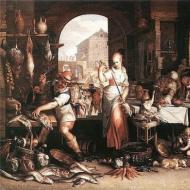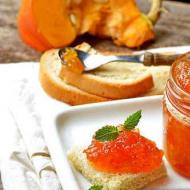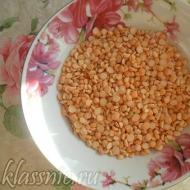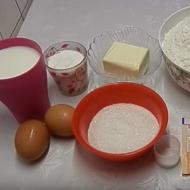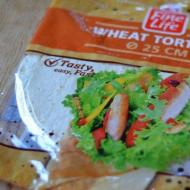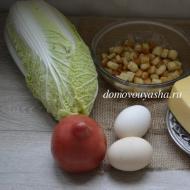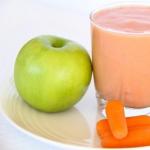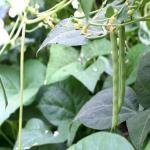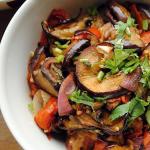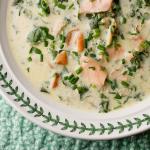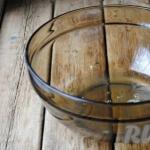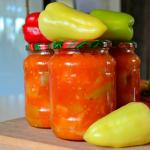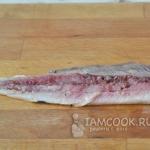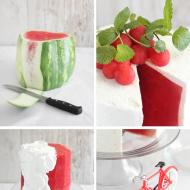
Borodino bread: benefits and harms. Why is Borodino bread dangerous? Borodino bread is eaten
“Bread is the head of everything” - this popular proverb has been saying for more than 100 years that not a single feast or daily meal is complete without the main product - bread. This hearty product perfectly complements any hot dish, cold appetizers, side dish or salads. The bread is baked from white and rye flour, with nuts, seeds, raisins and dried fruits added - the number of different varieties today reaches more than 30 types. The most popular of the dark varieties of bread is Borodinsky: we will talk about its composition, benefits and harms, as well as who can and cannot use this product in the article.
Composition and calorie content
The traditional Borodinsky recipe includes 2 main ingredients: rye flour (thanks to the choux pastry, characteristic voids are formed inside the product) and malt (because of it, the product acquires its dark color).
In addition, there are the following components of Borodino bread:
- second grade wheat flour;
- red malt;
- glucose and fructose;
- yeast;
- water;
- syrup;
- salt;
- spices (coriander, cumin, anise);
- proteins;
- cellulose;
- protein enzymes;
- minerals and trace elements (magnesium, iodine, phosphorus, iron, sodium, potassium and calcium);
- antioxidants;
- fatty acid;
- vitamins A, PP, group B.

It is noteworthy that the amount of protein in 1 piece of bread (25 g) is on average 10% more than in the same size piece of meat, and the B vitamins in such a rye product are an order of magnitude higher than in a similar product made from white flour.
Important! To extend the freshness of Borodino bread, manufacturers often deviate from GOST standards and add some preservatives to the product. To have confidence in the correct composition when making this product, it is better to make it at home or purchase only from trusted manufacturers who have a certified quality mark.
The calorie content of the product is 207 kcal per 100 grams of product. The ratio of BJU is 6.9: 1.4: 40.8.
According to GOST, properly made Borodino bread must meet the following indicators:
- taste: sweetish;
- appearance: uniform brick with a smooth shiny surface, sprinkled with seasonings (coriander, cumin or anise);
- additional impurities: no;
- smell: rich, slightly sour;
- dough: soft, homogeneous, not sticky;
- color: dark brown, uniform.
Video: about Borodino bread
Product properties
Like any other product, Borodino bread has both positive and negative effects on humans. Basically, the nature of this effect is determined by the amount of this product consumed, which can bring both benefit and harm.
Did you know? According to one version, Borodin bread was invented by the famous chemist and composer Alexander Borodin during his trip to Italy. According to another version, for the first time a flour product made from dark flour was baked within the walls of the Spaso-Borodinsky Monastery and was intended for mourning ceremonies. Borodino bread acquired its official name only in 1933, when the Moscow Baking Trust first established a unified recipe for the production of this product.
Benefit
Of course, the question: is such a product healthy can be answered unequivocally - yes, because most of it is rye flour, which is famous for its beneficial properties. But its daily use in unlimited quantities will lead to the opposite effect.  Let's look at the benefits of this rye product below:
Let's look at the benefits of this rye product below:
- Detoxification: The coarse fibers and fiber contained in this product gently cleanse the stomach walls of food debris, preventing it from stagnating in the stomach and releasing toxic waste. Bran, in turn, greatly facilitates the process of digesting food.
- Saturation of the body with a vitamin complex: Thanks to its unique composition, eating Borodino bread can improve vision, prevent the occurrence of heart diseases (including cardiac atherosclerosis), significantly improve hair quality (eliminates fragility and reduces hair loss), improve complexion, strengthen nails and even reduce the risk of cancer.
- Stimulation of protein metabolism: A set of essential amino acids is responsible for this process - once they enter the body, they are synthesized with non-essential amino acids that are present in every person and are absorbed into the blood, carrying protein throughout the body.
- Strengthening all digestive processes: this is possible thanks to glucose, fructose and polyunsaturated fatty acids, which also improve the functioning of the gastrointestinal tract.
- Removal of uric acid: Spices are responsible for this process - cumin, coriander and anise.
 It is noteworthy that the positive qualities of Borodino bread have led to its use not only in cooking, but also in cosmetology - this product is included as the main ingredient in many strengthening masks for hair growth.
It is noteworthy that the positive qualities of Borodino bread have led to its use not only in cooking, but also in cosmetology - this product is included as the main ingredient in many strengthening masks for hair growth. How can it harm the body?
The main harm that this rye product can cause is the oversaturation of the body with carbohydrates, which results in weight gain and subcutaneous fat deposition.
Did you know? Dark rye bread is one of the best folk remedies for anemia - containing a large amount of magnesium in its composition can successfully increase the number of red blood cells and improve their qualitative composition.
Of course, such a situation is only possible if the daily norm is significantly exceeded, which is 500 g for an adult and 250 g for children (over 6 years of age).
The high acid content makes it dangerous to consume products made from rye flour for people with high stomach acidity, as well as those suffering from ulcers and acute gastritis.  In addition, the use of this product should be limited or completely eliminated for people:
In addition, the use of this product should be limited or completely eliminated for people:
- with allergic intolerance to spices (cumin, coriander or anise);
- with severe visual defects (astigmatism);
- those suffering from stomach inflammation caused by excess gluten (enteropathy);
- having chronic heartburn, enterocolitis and bloating;
- children under 6 years of age (only in very small quantities);
- diabetics (the large amount of glucose in this product may be dangerous for people with high blood sugar).
Can I use it?
In addition to a certain circle of people suffering from certain diseases of the gastric system, limiting the consumption of dark bread is sometimes a necessary measure in certain situations. 
When losing weight
Everyone knows that white bread is a no-no for those who want to get in shape and lose weight, but not everyone knows that eating large amounts of rye bread can also add several kilograms.
The fact is that Borodino bread has a high percentage of carbohydrates to the total mass: as much as 79%! Sucrose along with fatty acids does not improve the situation, so for intensive weight loss you need to exclude this product from your diet, although, of course, consuming small portions of this product is not at all prohibited (no more than 100 g per day).
During pregnancy
Borodino bread, due to its vitamin composition, is a valuable product during pregnancy, but its quantity should be strictly limited: no more than 200 g per day, and in the last trimester - no more than 80–100 g.  Exceeding the recommended norm for a pregnant woman almost always causes digestive problems, since coarse fibers do not have time to be completely digested in the mother's body and cause bloating, heartburn or constipation.
Exceeding the recommended norm for a pregnant woman almost always causes digestive problems, since coarse fibers do not have time to be completely digested in the mother's body and cause bloating, heartburn or constipation.
Important! Strict restrictions on the daily consumption of rye bakery products for a pregnant woman are also caused by the need to limit the amount of heavy flour products during this period. It is not recommended to eat Borodino bread for women suffering from toxicosis: the active acids in this product can only aggravate the situation.
When breastfeeding
A nursing mother should also not overuse dark rye bread: firstly, spices and a large amount of sugar in this product can cause allergic reactions in the baby, and secondly, consumption of such a heavy flour product by a nursing woman can cause stomach upsets and severe colic in the baby.
For diabetes
People with high blood sugar levels need to very carefully control their consumption of Borodino bread. Of course, the permissible daily amount will depend on what other foods are included in the daily diet, and whether among them there are foods with a lot of sugar.  In any case, diabetics must agree on the use of dark rye bread with their doctor - only he can assess the patient’s health condition and determine the required amount of this product, which will not cause harm to health.
In any case, diabetics must agree on the use of dark rye bread with their doctor - only he can assess the patient’s health condition and determine the required amount of this product, which will not cause harm to health.
Did you know? According to rough estimates, more than 9 million units of bread are eaten every day all over the world, and this does not count all kinds of buns, hamburgers, crackers, pita bread and other baked goods.
Borodino bread is one of the healthiest flour products: its rich vitamin composition can heal and improve many functions in the body. However, excessive consumption of such a product is fraught with excess weight and stomach problems.
Reasonable adherence to the daily intake of Borodino bread will allow you to get the maximum benefit from this tasty, satisfying and aromatic bakery product.
Borodino bread has been present on store shelves and on the tables of people in the CIS countries for decades, and is loved by many for its unique aroma and taste of cumin. These delicious-smelling buns first appeared on Soviet shelves in 1933.
It is not clear who first came up with the idea of making spiced bread. The most plausible version is that the nuns from the Spaso-Borodinsky Monastery, built by the general’s widow Margarita Tuchkova, baked black bread according to a classic recipe. Having lost her husband in the memorable Battle of Borodino, the woman founded a church not far from the place of his death, which then turned into a temple. Having become abbess, Tuchkova, together with other nuns, made special, memorial bread in memory of her husband and other fallen soldiers. According to the second, less popular theory, the chemist and composer Borodin brought the recipe for rye bread with caraway seeds from his numerous trips to Italy. One way or another, this type of bread has become a highlight on many people’s tables.
Classic Borodinsky is baked from wheat and rye flour, yeast, molasses, rye malt, and sugar. An interesting fact is that of the total amount of flour, only 15% is rye, the rest is wheat. But even this amount is enough to give the future loaf the color, taste and aroma of black.
According to the original GOST, the dough is made choux, thanks to which the bread remains fresh for a couple of days, the main thing is not to store it together with white bread or in a plastic bag. Borodinsky's crust is always well baked, without cracks, and has a thickness of 4-5 mm. Its upper part is shiny and sprinkled with coriander or cumin. The crumb is porous and not sticky. Bread can be produced in the form of both hearth and molded products.
Beneficial features
It has long been believed that black bread is healthier for the body than white bread. What caused this opinion, and is it justified? Definitely yes. Borodino bread contains large quantities of many elements necessary for health - for example, vitamin PP affects the metabolic process in living cells; Vitamin B1 (also known as thiamine) affects the functioning of the nervous system and those parts of it that are associated with the digestive system. A lack of vitamin B1 will definitely affect the body in the form of constipation, so it is extremely important for people suffering from this scourge to use Borodinsky to normalize intestinal function.
In addition to vitamins, bread contains microelements:
- phosphorus (157 mg);
- iron (3.9 mg);
- sodium (406 mg);
- potassium (235 mg).
As well as protein compounds and beneficial enzymes. For comparison, the average daily requirement for the human body is: potassium 250 mg, iron 10-15 mg, phosphorus 800 mg. That is, most of the necessary nutrients can be obtained from just one loaf of Borodinsky!
Don't forget about fiber. Due to it, peristalsis in the intestines improves (that is, the movement of food through it accelerates), and also cleanses of toxins and eliminates toxins. It is worth remembering that you need to consume foods wisely and not get carried away, so as not to cause negative consequences. Those who have a problem with the acidity of gastric juice and the presence of ulcers in the gastrointestinal tract should not be more careful with bread. It is not recommended to consume too much Borodinsky. Diabetics and those suffering from stomach colic should not overuse bread.
Dietary properties of the product
The calorie content of Borodino bread is of interest to everyone who monitors their diet and controls their weight. I am glad that this type of bread is recommended by nutritionists for weight loss. One bread weighing 300 grams (standard weight of a loaf) accounts for 207 kcal, where about 163 kcal comes from carbohydrates, 27 kcal from proteins, and 17 kcal from fats. But do not forget that regular white bread has a slightly higher calorie content - about 260 kcal. But many still prefer Borodinsky because it contains more fiber.
Food preparation recipes
Borodino bread is easy to prepare at home - fortunately, there are good and understandable recipes.
Recipe for Borodino bread in a bread machine
Borodino bread in a bread machine is prepared from the following ingredients: 360 ml of water, 2 tbsp. l. honey, 100 g wheat flour, 450 g rye flour, 1.5 tbsp. l. apple vinegar, 2 tsp. dry yeast, 2 tbsp. l. oil (vegetable), 1.5 tsp. salt, 4 tablespoons of rye malt, coriander or caraway seeds to taste.
We set the rye bread baking mode on the bread machine. Pour the malt into a separate bowl, pour boiling water over it, stir and let it brew for 7-8 minutes. Pour yeast, pre-sifted flour of both types, salt into the bowl of a bread machine, add honey (preferably in liquid form). Finally, any vegetable oil, unrefined, or vinegar. Add malt to the resulting mixture and add water. It is advisable to pour in the liquid not all at once, but gradually, focusing on the consistency of the dough. If the dough wraps around the spatula, everything is done correctly. During cooking, it is better not to look every minute so as not to disrupt the operation of the bread machine. When Borodinsky is ready, take it out and place it on a towel or wire rack to cool slightly.
Borodino bread with fresh yeast
Homemade Borodino bread according to this recipe is prepared using the following ingredients: 300 grams of rye flour, 1 teaspoon of table salt, 170 grams of wheat flour (you can take either grade 1 or 2), 1 tbsp. l. honey, 15 grams of fresh yeast, 1 tablespoon of oil (vegetable), 400 ml. water, 2 tbsp. spoons of rye malt, 1 tbsp. l. cumin and coriander. The required oven temperature is 180°C.
Pour malt into a deep bowl, pour 150 ml of boiling water, leave to cool to room temperature. In another container, dilute honey and yeast in 150 ml of hot water, mix and place in a warm place to allow the yeast to ferment. If everything is done correctly, bubbles will appear above the starter.
Two types of flour will need to be sifted into a container, add salt. Make a hole in the middle into which to pour the starter and malt, the remaining water and vegetable oil. Knead the dough until smooth, then let it sit in a warm place for 1.5 hours. The dough will increase greatly in volume. Before baking, divide the dough between the molds. Before putting into the oven, cumin and coriander seeds are sprinkled on top of the dough and pressed a little. Leave the dough for another 30-40 minutes, preheat the oven. Bake for 40 minutes at 180°C. Once cooked, remove the bread to a wire rack or towel and let cool. You should wait a couple more hours before slicing into the flavorful loaf.
Bread with nuts and raisins
The third recipe can be called a variation of the classic Borodino recipe. To prepare such bread, you need to take 400 g of flour, always premium wheat, 150 g of finely chopped walnuts and raisins, 10 grams of fresh yeast, 100 grams of rye flour, 10 grams of salt and 350 mg of water.
The flour is sifted and mixed with salt, the yeast from the briquette is added to the flour mixture and rubbed with your hands. Add water and knead the dough with a spoon, as it will simply be inconvenient to use your hands. Add raisins and nuts to the dough, knead until smooth and elastic, adding flour if necessary. Transfer the dough to a bowl and let it sit warm, but no more than 1 hour. After time has passed, pour the dough into the molds and leave in them for another hour. Bake first for 10 minutes at 220°, and then for another 20 minutes at 200°C. Place the finished bread on a towel or wire rack and let cool.
Snacks
Borodino bread can (and should) be used as a base for snacks when you urgently need to come up with something interesting for the arrival of guests. For example, sandwiches with champignons. To prepare them, rub the bread with garlic and fry in a frying pan. After cooling, spread the slices with mayonnaise or sandwich paste, put a couple of slices of champignons and some greens on top. It takes very little time, but is very tasty.
An excellent snack to go with beer – garlic croutons. To prepare them, you need to cut the bread into small pieces. Grate the garlic on a very fine grater, add chopped dill, pepper and salt, add a little olive oil. Dip pieces of Borodino bread into the resulting mixture and place on a baking sheet. Bake until crispy in the oven at 200°C.
A good option for a feast is sandwiches with cottage cheese and smoked fish. To prepare it, it is better to take hot smoked mackerel, from which all the bones have been removed. Load soft cottage cheese, sour cream, fish into a blender and grind until smooth. Pour into a bowl, add herbs and green onions, spread on bread - ready!
Fragrant and tasty Borodino bread, so familiar to us since childhood, is not only good for the body, but also serves as an excellent basis for light or hearty snacks.
Irina Kamshilina
Cooking for someone is much more pleasant than for yourself))
Mar 30 2017
Content
How this type of bread appeared is not known for certain. There is a version about the first time it was baked in the Borodino Monastery. Today Borodinsky is a favorite product of many people; it can even be found in Russian stores in Italy. It is extremely healthy, rich in vitamins, and has an excellent taste and smell.
The benefits and harms of Borodino bread
What are the benefits and harms of Borodino bread? It belongs to dietary types of baked goods, is rich in microelements and other useful substances more than other varieties, and in comparison with white bread, it also benefits in the amount of vitamin B1. The product is also rich in vitamin A, iron, magnesium, phosphorus, and proteins. An important component of baking is fiber - it cleanses the intestines of accumulated toxins and waste, so nutritionists advise eating black Borodino bread when losing weight.
By regularly consuming this product, you prevent the occurrence of diseases such as constipation, dysbacteriosis, atherosclerosis, gout, and oncology. There are also contraindications: diabetics should use black bread with caution - it contains sugar. High acidity precludes its use by people suffering from peptic ulcers and gastrointestinal problems. It is better to exclude this product in case of flatulence, because the presence of rye flour causes increased gas formation.
Composition of Borodino bread
All ingredients for this baked product can be purchased in regular supermarkets at an affordable price. The composition of Borodino bread is simple. The main components are: rye, second-grade wheat flour, malt, yeast or starter, salt, sugar, water. An obligatory ingredient is also a spice such as coriander, which can sometimes be replaced with cumin or anise. Molasses serves as a special flavoring additive; its absence is compensated for by honey, and cumin grains are garnished.
How to bake Borodino bread at home
There are two ways to bake Borodino bread at home: with yeast or sourdough. Which one you prefer is up to you, but when starting the process for the first time, stop at the easiest one, not the most difficult one. Each housewife chooses her own baking method: in the oven, in a slow cooker, in a bread maker. The latter is the simplest; the machine itself selects the desired temperature and baking time. If you wish, you can add bran to any recipe - this will not spoil the taste, but will benefit the stomach and the whole body.
What do you sprinkle on top of Borodino bread?
When answering the question of what Borodino bread is sprinkled on top of, you need to turn to the origins of its origin. According to legend, it was first baked by the wife of General Tuchkov after the death of her husband in the Battle of Borodino. At that place, Margarita built a monastery, where they began to bake the famous bread. The dark color of the crumb symbolized grief, loss, and the coriander seeds, which were powder, meant buckshot. Nowadays, cumin and sesame are used to sprinkle buns. Coriander is the main component of the original recipe and gives the product a unique aroma.

Borodino bread recipe
There has long been a custard recipe for Borodino bread. Its taste was specific, and it took a lot of time to bake. The manufacturing technology was secret and was made public only recently. The modern recipe, composition, technology are simplified, fermented milk products included in the original composition are not required, and the bun has the same famous taste and continues to be in great demand. Housewives learned to bake the product at home using modern technology.
Recipe for Borodino bread in a bread machine
- Cooking time: 240 min.
- Number of servings: 6 persons.
- Calorie content of the dish: 210 kcal.
- Purpose: lunch.
- Cuisine: Russian.
The recipe for Borodino bread in a bread machine is so simple that it allows even a novice cook to get acquainted with baking technology. For housewives who have such equipment, the task is greatly simplified. There is no need to waste time on mixing the ingredients, there is no need to waste the dough, the machine will do everything itself. There is more than one recipe for Borodino bread for a bread machine, so when starting the process for the first time, choose the easiest one.
Ingredients:
- wheat flour – 225 g;
- rye – 325 g;
- yeast – 2 tsp;
- honey - 2 tbsp. l.;
- malt – 40 g;
- water – 80 ml;
- ground coriander – 1 tsp;
- salt – 2 tsp;
- vegetable oil – 2 tbsp. l.
Cooking method:
- Thoroughly stir the malt in warm water and cool.
- First pour the yeast into the bowl of the bread machine, then a mixture of two types of flour, and salt.
- Pour in the oil, malt mixture, add honey, coriander.
- Bake for 3.5 hours.

Borodino bread in the oven
- Cooking time: 4.5-5 hours.
- Number of servings: 7 persons.
- Calorie content of the dish: 210 kcal.
- Purpose: lunch.
- Cuisine: Russian.
The recipe for Borodino bread in the oven will help the culinary abilities of housewives who do not have a bread machine. You need to combine the ingredients and knead the flour base manually, but the recipe and composition of the components remain the same. Borodino hearth bread at home in the oven turns out to be very aromatic, nutritious, and can be stored for a long time. You can enhance the taste with herbs and spices such as cumin or anise, but you should not mix everything.
Ingredients:
- rye flour – 1 tbsp;
- wheat - 300 g;
- malt – 2 tbsp. l.;
- warm water – 300 ml;
- yeast – 1.5 tsp;
- sugar – 1 tbsp. l.;
- salt – 1.5 tsp;
- coriander – 1.5-2 tsp;
- cumin – 1.5 tsp.
Cooking method:
- Dissolve yeast and sugar in 100 ml water, set aside for 10 minutes. You need to stir until the yeast is completely dissolved.
- Add malt, flour, the rest of the water, stir well.
- Add salt, coriander, cumin, knead the dough. Cover and place in a warm place for 1.5-2 hours.
- When the dough has risen, form a loaf and set aside for another 1.5 hours.
- Leave the baking sheet in the oven for 0.5 hours at 180 degrees.

Recipe for Borodino bread according to GOST
- Cooking time: 7-8 hours.
- Number of servings: 7 persons.
- Calorie content of the dish: 207 kcal.
- Purpose: lunch.
- Cuisine: Russian.
- Difficulty of preparation: easy.
The recipe for Borodino bread according to GOST can be with or without yeast. The technology consists of the following steps: preparing the tea leaves and dough, kneading the dough, baking. Adding ingredients requires a certain sequence. Having tried the product for the first time, you will forever refuse store-bought baked goods and will only prepare Borodinsky bread yourself.
Ingredients:
- rye flour – 330 g;
- wheat – 75 g;
- malt – 25 g;
- water – 50 g;
- hot water – 250 g;
- honey – 20 g;
- coriander – 1 tsp;
- rye sourdough – 150 g;
- sugar – 30 g;
- salt – 6 g;
- coriander beans – 2 tbsp. l.
Cooking method:
- Start with the starter: mix 75 g of rye flour, malt, ground coriander. Pour boiling water, wrap the container well, and place in a warm place for 2 hours.
- Dilute salt, sugar, honey with warm water.
- Mix with sourdough, water, two types of flour. Knead the dough to a thick consistency so that the spoon does not sink into the container.
- Grease a bowl with oil, place the dough, cover with a lid. Leave for 2-4 hours.
- Grease a baking dish, lay out the dough, and press down thoroughly. Cover with foil and leave for another 2 hours.
- Preheat the oven to 220 degrees, brush the dough with water, sprinkle with coriander grains, bake for 15-20 minutes. Reduce temperature to 200 degrees, bake for another 60-65 minutes.
- The finished product should be covered and left to ripen for an hour.

Recipe for Borodino sourdough bread
- Cooking time: 6-7 hours.
- Number of servings: 5 persons.
- Calorie content of the dish: 214 kcal.
- Purpose: lunch.
- Cuisine: Russian.
- Difficulty of preparation: medium.
The recipe for Borodino sourdough bread involves preliminary preparation of rye dough. The process is a bit hassle-free and takes time, but the end result is worth it. Before kneading the dough, you need to carefully sift the flour so that there are no lumps or foreign particles in it. To prepare, use dark raisins - they will give the characteristic deep, dark brown color to the crumb.
Ingredients:
- rye flour – 500 g;
- wheat – 80 g;
- malt – 45 g;
- honey (dark) – 2 tbsp. l.;
- vegetable oil – 2 tbsp. l.;
- vinegar - 2 tbsp. l.;
- water – 380 ml;
- sugar – 2 tsp;
- raisins – 1 handful;
- coriander seeds;
- warm water – 1 tbsp.
Cooking method:
- Before kneading, prepare the starter: crush the raisins, add sugar, half the water, 2 tablespoons of wheat and 3 tablespoons of rye flour. Leave it for a day.
- Strain the fermented mixture and add the same amount of flour. Pour water, add 1 teaspoon of sugar, close and leave for another day.
- Make the dough: mix 1 tablespoon of starter, 70 g of wheat flour, set aside in a warm place for 1 hour.
- Combine 80 ml of boiling water with malt, close the lid, and set aside for half an hour.
- Knead the dough: mix the dough, malt, honey, oil, vinegar and the rest of the rye flour. Cover with a lid and place in a warm place for 4 hours.
- Grease the pan with oil, lay out the dough, and leave to rise for 35-40 minutes. Trim with wet hands and sprinkle with coriander seeds.
- Bake for 1 hour at 200 degrees.

Borodino bread - cooking secrets
When starting to bake the product at home, it won’t hurt to learn the secrets of making Borodino bread. Experienced chefs advise not to deviate from the basic technology for preparing this bakery product and to follow these recommendations:
- you need to take good quality flour;
- be sure to sift it before kneading the dough;
- make your own starter;
- add only fresh yeast and spices;
- After baking, let the product sit, preferably up to 10 hours.
Borodino bread is one of the most favorite types of bread for so many people - its unforgettable taste and aroma are immediately remembered, you can’t confuse it with anything else - it’s delicious like few others! Baking one of these is not an easy task; often what you get is not exactly what you need. But it is quite possible to learn, knowing the composition of Borodino bread according to GOST and its recipe - they will be discussed in this article.
Borodino bread belongs to the custard varieties of rye bread and is baked without preservatives or taste improvers.
Due to the fact that the flour is brewed with boiling water and the fact that the dough then matures for quite a long time, the bread turns out to be special - and has a pleasant taste, aroma and color (the bread is very dark).
So, the composition of Borodino bread according to GOST (Borodinsky rye bread) - per 100 kg of flour:
Rye wallpaper flour - 80.0
Wheat flour 2nd grade - 15.0
Starch - 0.2
Red rye malt - 5.0
Pressed yeast - 0.1
Sugar - 6.0
Molasses - 4.0
Vegetable oil - 0.05
Coriander - o.5
Total raw materials - 101.71 kg.
If there is no malt (and you can buy it today, it is sold in bakery stores), but if you haven’t found it, then malt can be replaced the same amount of dry kvass or kvass wort.
Instead of molasses You can use honey or corn syrup.
Unlike simple rye breads, the dough for Borodinsky is prepared using tea leaves and spices.
Infusion is rye malt mixed with flour and brewed with boiling water. The brewing process takes several hours - the quality of the finished bread depends on the brewing. Before brewing, ground spices (cumin or coriander, sometimes anise) are added to the malt; they actively release aromatic substances, and the spices enhance the fermentation of the dough, it becomes looser and fluffier. The dough is prepared using a sponge or straight method using a thick starter. According to classical technology, yeast is not used in the preparation of Borodino bread, but according to GOST it is allowed to be used. But sugar is definitely used.
Borodino bread lasts longer than other varieties thanks to the choux pastry, so it is good to take on the road or on a hike.
Borodinsky can be baked in a bread machine ("special" mode).
It’s better not to eat it fresh, only the next day, and after 2-3 days it becomes even better.
You can put kvass on Borodino bread.
Recipe
One of the simplest recipes for Borodino bread.
Sourdough prepare in advance leave for 14-16 hours:
- 70 g rye wallpaper flour
- 70 g water
- 1 tbsp. l. old ready-made sourdough - if you don’t have it, then prepare it several days in advance, feeding the rye flour with water about 2 times a day (we start literally with a spoonful of flour, otherwise in a few days there will be a LOT of it)
Welding:
- 80 g rye wallpaper flour
- 25 g red (dark) fermented rye malt
- 1.5 teaspoons ground coriander
- 250 g boiling water
Mix flour, malt and coriander. Remove boiling water from heat and slowly add flour (with malt-coriander). Cover and place in the oven at 65 degrees, 2 hours. Then take it out and let it cool. It looks like a paste, cream, very dark in color, aromatic.
OPARA
- Take all the resulting starter and tea leaves
- 170 g rye wallpaper flour
- 50 g of water (you may not need it, look at the test)
- 0.5 g fresh yeast (if you want it quickly, but in general it’s better without it)
Mix the starter, tea leaves, and flour (including yeast, if you use it). If necessary, add enough water so that the dough can be stirred with a spoon, like good sour cream; it should be thick enough. Cover and leave in a warm place for 3-4 hours (if with yeast, then 45 minutes). The volume of the dough should increase approximately 2 times. Then she's ready and fit well
DOUGH
- The whole dough
- 80 g water
- 20 g molasses
- 30 g sugar
- 100 g rye wallpaper flour
- 75 g 2nd grade wheat flour
- 10 g salt (you can increase or decrease it to taste, try the dough)
- Whole coriander for sprinkling (optional, optional)
Dilute molasses and sugar in water, add dough, flour and salt to them, knead the dough, not very thick, it remains very sticky (because it is rye), it should not be liquid and should not be dry. You don't need to knead for too long, you just need to mix well. It's a bit difficult with your hands - it's sticky, but in general it's possible.
Cover the finished dough and leave for half an hour.
This bread is not hearth bread, we bake it in a mold.
Grease the mold with oil, place the dough there, smooth the surface (with a wet hand), sprinkle coriander on top if desired, cover and leave to rise for 3 hours (with yeast - an hour) at room temperature, the volume of the bread should increase by about 2 times.
Preheat the oven to 240 degrees.
Place the risen bread in the oven and bake for 10 minutes. with steam, and then reduce the temperature to 200 degrees and bake for about an hour or a little less. Carefully remove the finished bread from the pan and cool on a wire rack.
History of Borodino bread. The emergence of GOST
At the turn of the 19th and 20th centuries, as well as after 1917, before the introduction of GOST standards in 1938, Borodino bread was baked in Moscow only using a 4-step method, and this the bread was hearth-bread, not molded. Cumin or anise was added as spices, and bread was baked exclusively from rye flour (a mixture of whole grain and peeled). According to GOST, the recipe for Borodino bread became simpler, one process out of four was removed, wheat flour was introduced, etc. They developed a unified standard - apparently this is where the name “Borodinsky” bread came from, although this is not known for sure. From Soviet times, we remember just such Borodinsky. Today's Borodinsky is no longer the same, although many modern people like it. But if you bake real homemade Borodino, you won’t want the store-bought kind anymore.
To bake a real Borodinsky, it takes 12 hours. This bread is prepared with sourdough and consists only of whole grain rye (wallpaper) flour and peeled flour, without wheat.
Spices, spices for Borodino bread
Coriander, caraway seeds, or anise are traditionally used for Borodino bread. You can experiment with these spices to see what you like best. You can mix them with each other.
You can add raisins.
Ancient Borodino hearth bread, recipe
If you want to try the same century-old Borodino hearth bread, then you need to take a little less water in it than in the molded bread. And the spices are different - coriander is usually added to the mold, not cumin or anise.
The beginning of everything is sourdough. It will be around 6 o'clock. For it you need:
15 g of mature rye sourdough, we prepare it in advance, it lives in the house for a long time
- 30 g rye wallpaper flour
- 30 g peeled rye flour
- 40 g water
The total will be about 90 g of starter.
Mix and leave to rise for about 6 hours, at a temperature of about 30 degrees. If it’s cold, look for a warm place, but don’t overheat either.
Once the starter has been placed, we begin brewing:
140 g peeled rye flour
- 28 g red rye malt
- 1 g ground cumin or anise, to choose from
- 380 g boiling water
Total about 520 g.
Stir everything - it smells very tasty. Then we keep the tea leaves for 2-2.5 hours at a temperature of about 60 degrees. If you have a stove, there are no problems, but if you don’t, you have to figure out how to keep the tea leaves warm. In this case, the brew is, as they say, “saccharified.” Next, cool it to the ferment temperature, about 30 degrees. As a result, we should get a tea leaves with a more liquid consistency than we initially put in, and the taste should be noticeable.
When the leaven is ripe, the brew has already cooled down, approximately at the same time. Now you need to place the dough. Mix the starter and tea leaves, cover with a lid and linen cloth, and leave for 4 hours. When the dough has risen, knead the dough.
Add to the dough:
250 g rye wallpaper flour
- 125 g peeled rye flour
- 5 g salt
- 30 g sugar
- 10 g molasses
Mix everything well, cover, let stand for about half an hour or a little less, at 30 degrees.
At this time, heat the oven to 230-240 degrees. If you have a baking stone, great; if not, take the baking sheet you have. We form a loaf of hearth bread with our hands, place it on a baking sheet (stone), and let it stand for 10-15 minutes.
Sprinkle the bread with water before placing it in the oven. Bake with steam for 40-45 minutes.
The taste of this bread is unsurpassed!

Hello.
I offer my recipe for Borodino rye bread.
p.s. I downloaded all the recipes I found and baked them in a Panasonic 2502 bread machine and was completely disappointed. But it helped me make the recipe myself. And so far (in my opinion, of course) it has not yet been surpassed!! VERY TASTY!The recipe is very simple and affordable! Despite the new names...
You must have electronic scales.
A teaspoon and a tablespoon were provided with the stove.470 ml water
420 g rye flour (I use Raz and Kvass Auchan)
75 g - wheat (I use Makarna Auchan)
1 and 1/2 tablespoons - Extra - R (Dark Rye Store 108 spices)
1 tsp - salt (fine sea salt)
Honey 2 tbsp (can be replaced with sugar 2 tbsp boil in the water used for 3 - 5 minutes)
Fermented rye malt 4 tablespoons (108 spices)
Ground coriander 1 tsp (108 spices)
Butter 20 g
tremors 2 and 1/2 tsp. (I use dr. Oetker is rarely on sale, of course it’s saf moment, but Oetker is better)Preparation:
pour 4 tbsp into 100 ml boiling water. L spoons of malt + coriander 1 tsp. + 20g butter + honey (or boil sugar in water beforehand, remember 100 ml! Water boils away)
All this is brewed for 5 minutes
While it's brewingRye flour 420g + 75 wheat + 1 and 1/5 Extra R 1 and 1/2 +
salt 1 tsp = in a baking bowl. In my case, the bread maker is Panasonic SD ZV 2502Add 100 ml of the remaining water to the brewed part 370 ml (this proportion is due to the overall temperature of the water)
and pour into the bowl of the bread machine
Pour 2 and 1/2 tsp of yeast into the yeast compartment of the bread machine.
Rye mode (after turning on the kneading, you can help with a spatula)
The height of the bread should be 10 cm
If there is a problem that is unforeseen for me, due to ingredients, etc., reduce the water to 10 ml water or 20 mlGennady Krotov

Thanks for the wonderful recipe and interesting information about its history. Everything worked out for me, although I deviated somewhat from the recipe - instead of sourdough I used leaven grounds - the dough turned out wonderful, very loose, lively, and rose well. I didn't use yeast. Instead of molasses, I added honey and raisins to the dough. I baked it not in classic forms, but on baking sheets - this did not affect the taste - the bread was well baked, did not burn anywhere, acquired a very appetizing crust and the right pulp.
Gennady, thank you for the recipe; when it is tested and suffered through personal experience, the result is exactly what is needed.
We are now baking without a bread machine again, so we will check and try for ourselves, based on your recipe.
Hi all. Where can you use Borodino bread?
It depends on the marriage. If it’s edible, it will be quite suitable for kvass.
Interesting, using kvass grounds - I’ll try that too in the summer, thanks!
Good luck! I hope it works out for you too. I pre-grinded the kvass grounds in a blender so that they were homogeneous and without lumps.
I live in the Pamirs. I'm going to make my own mini bakery on an area of 60 square meters. m. Unas board. there is no bread at all. Our town is small with a population of 30. thousand. This will be the first bakery to make beards. bread I'm really looking forward to your advice, friends. Mahmadi Benazirov as classmate. Then I’ll open mail.ru
If you can get flour and the rest of the ingredients, then everything is quite simple, you just have to try the recipe, and when it turns out delicious, it’s ready.
For defective bread, we cut it, dry it, grind it (stupidly with a meat grinder) and add fresh filling (a little at a time). The ingredients are the same, so it's no big deal. Just look at the consistency
Thanks for the recipe..... But, based on 100 kg of flour? ....why not a ton at once? ....
Well, this is a GOST industrial recipe, they don’t bake little by little ☺
Regarding the old method. What does it mean to "bake with steam"? And what should a baking stone be? Are granite tiles okay?
With steam - this is when a container of water is standing in the oven. Granite tiles, if it is a stone specifically for baking, are quite suitable.
I'm just about to start baking bread
For dona with a question about the possibility of baking bread on granite tiles. Do you and your advisors know that granite is radioactive? Don't you feel sorry for yourself and your family? There are plenty of stone tiles special for ovens on sale. Produced by Belarus, Karelia. Type in the search and you will get a lot of offers. It's better than asking people who don't know anything.
Yeah, Yuri... So you put a sandwich on a granite embankment in the city or on a boulder in nature - and that’s it, you can throw it away, otherwise you’ll be irradiated by this sandwich. Guys, don't fall into insanity. Textbooks from the school curriculum to help.
Gentlemen, I'm waiting for advice and training. I bake at home for my family, I try everything. It is interesting to try dark (black) breads with various seasonings. “Borodinsky” breads are a dream... how to make sourdough correctly? How long can it be stored in the refrigerator? Teach to bookmark for home. I'm really looking forward to it
I have exactly the same one as in the store, black and Borodinsky do not come out. White - yes, and much tastier, gray. Black also works, but it's different. HOW they bake exactly that bread... apparently, it’s a long-established technology. And, as far as I know, it is multi-stage and quite complex.
Regarding granite, it’s really better not to take risks. When we were students, we did laboratory tests, Khojili measured the level of radiation at the university, and granite marble produces an increased radioactive background. I have several ceramic tiles stacked on top of each other and wrapped in foil that make a very good stone
Baking with steam means. When you put bread in the oven, open the door a little and spray water in with a spray bottle about 15 times
Physicist, what does increased mean? 25-30 microR? 60? How much does marble have? Marble is metamorphosed chalk, roughly speaking. Where does the radioactivity come from? True, we call everything marble. Any light stone is immediately “marble”. And any dark one is “granite”.
And in general - don’t scare people, they wrote correctly about granite boulders. The clay from which your ceramic tiles are made also comes from the weathering of granite.

